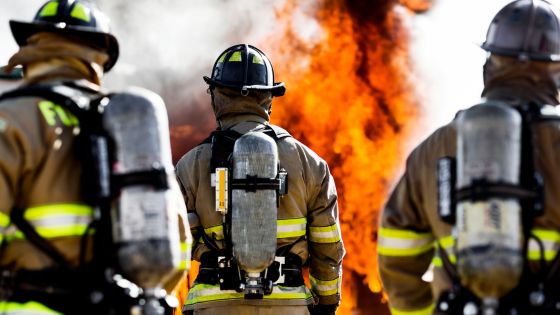Firefighters are often hailed as heroes for their bravery in fighting fires and rescuing people in danger. However, many people do not realize that these firefighters are also exposed to various health hazards while on the job. One of the biggest concerns for firefighter health in recent years has been the use of Aqueous Film-Forming Foam (AFFF), a fire suppressant foam that contains harmful chemicals.
This article will explore the link between AFFF and firefighter health and the ensuing legal battle for compensation.
Health Risks Associated With AFFF Exposure
Exposure to AFFF has been linked to several health risks for firefighters. It contains perfluoroalkyl and poly-fluoroalkyl substances (PFAS), known to be toxic and linked to several health problems. These include cancer, immune system dysfunction, and reproductive and developmental issues.
The New York Times published that a study in 2020 found that PFAS chemicals have been detected in the drinking water of more than 200 million Americans. In addition, some communities show levels exceeding the recommended safety limit the Environmental Protection Agency set.
It highlights the widespread and persistent nature of PFAS contamination and the potential health risks associated with AFFF exposure for not only firefighters but also the general public.
Firefighters who work at military installations or airports, where AFFF is used extensively for firefighting and training, are at even greater risk of exposure. As a result, there is growing concern about the long-term health impacts of AFFF exposure on firefighters and the need for more protective measures to be implemented to reduce exposure levels.
Legal Battle for Compensation
The link between AFFF exposure and firefighter health has led to a legal battle for compensation. Several lawsuits have been filed against manufacturers of AFFF, alleging that they knew about the health risks associated with the product but failed to warn firefighters or provide adequate safety measures.
Many of these lawsuits have resulted in settlements. AFFF lawsuit settlement amounts vary based on factors such as the extent of the plaintiff’s injuries and the strength of the evidence presented. TorHoerman Law, LLC mentions that according to legal experts, the potential AFFF lawsuit settlement amounts could be as high as $300,000 or more, depending on each case’s specific details and strength.
However, the source also specifies that there have been no resolutions or agreements reached in the AFFF multidistrict litigation (MDL).
Corporate Responsibility and Accountability
The issue of AFFF and firefighter health raises crucial questions about corporate responsibility and accountability. For example, many lawsuits against AFFF manufacturers have alleged that these companies were aware of the health risks associated with their products but failed to inform the firefighters about the potential dangers.
As a result, there is a growing call for greater corporate responsibility and accountability in using chemicals like AFFF. It includes more transparent disclosure of the potential health risks of these chemicals, as well as more rigorous safety testing and regulation.
In response to the growing concerns about PFAS contamination, some manufacturers have taken steps to reduce or eliminate the use of these chemicals in their products. For example, in 2020, 3M announced that it would no longer produce or sell AFFF products that contain PFAS chemicals.
The Role of Government Regulation
The use of AFFF and the associated health risks have also raised questions about the role of government regulation in protecting public health. For example, while some regulations exist to limit the use of certain chemicals in consumer products, the regulation of industrial chemicals like PFAS has been more limited.
However, there has been increased attention to the need for stronger regulations and oversight of PFAS chemicals in recent years. The EPA has recently proposed a rule to prevent the manufacture, processing, or use of approximately 300 per- and poly-fluoroalkyl substances (PFAS) without undergoing a complete EPA review and risk determination.
This rule is intended to help protect public health by thoroughly evaluating these chemicals before being used or manufactured.
These actions by the government represent a vital step towards protecting public health from the risks associated with AFFF and other PFAS-containing products.
The Need for Safer Alternatives
While AFFF has been widely used for decades due to its effectiveness in suppressing fires, its high levels of PFAS have been linked to numerous health problems. These include cancer, thyroid disease, and developmental delays.
Efforts are underway to develop and promote alternative firefighting foam products that are safer for firefighters and the environment. These alternatives may include foam products that are PFAS-free, have lower levels of PFAS, or use alternative chemicals that are less toxic.
Firefighters and other first responders must have access to safe firefighting foam products that do not threaten their health or the environment. Promoting safer alternatives to AFFF can help protect public health and prevent future harm from exposure to harmful chemicals.
Public Awareness
In recent years, there has been a growing public awareness of the health risks associated with PFAS chemicals, including their widespread presence in the environment and potential health impacts. For example, a survey conducted by the Environmental Working Group found that more than 50% of Americans included in the survey said their tap water is unsafe for drinking.
However, despite the growing concern about tap water quality, a significant proportion of people are unclear about who is responsible for safeguarding it.
This increased awareness has led to enhanced public pressure on companies and government agencies to take action to address the risks associated with PFAS exposure.
Final Words
Aqueous Film-Forming Foam (AFFF) has been a critical tool in firefighting for decades, but its health risks cannot be ignored. Firefighters and other first responders are at risk of exposure to PFAS through the use of AFFF, which has been linked to numerous health problems.
The legal battle for compensation has helped to bring attention to the issue and hold manufacturers accountable for the harm caused by these products.
A comprehensive approach can help protect the health and well-being of firefighters and the general public. Working together to address this critical issue will ensure that those responsible for the harm caused by AFFF are held accountable and that safer alternatives are developed and used to minimize the risks associated with exposure to PFAS chemicals.




















